Basal Cell Carcinoma (BCC) is an increasingly frequent pathology in the vast majority hospital of Paraguay.
The Nasal region suffers from a disadvantage with respect to its position compared to other parts of the body that are not exposed to ultraviolet radiation, these neoplasms generally have an excellent prognosis, mainly due to their lack of lymphatic spread, distant metastases, self-limitation. Bilobed flaps represent an excellent option for small skin defects, its practical and aesthetic.
Keywords: Basal cell carcinoma, Bilobed flap, UV radiation
Basal Cell Carcinoma (BCC) represents an increasingly common skin disease in the world population, and Paraguay is no exception. Various factors have contributed to the higher prevalence and incidence of this disease, factors that are easily found in the national population.1-3 The population most affected is seen among older adults (50 to 59 years) with a slight predisposition to females (54.6%) according to studies conducted by the National University of Asunción. These patients come early because these lesions are found in the facial region.3 They invade adjacent tissues and structures by direct extension and therefore leave significant aesthetic deformities if left to evolve freely, but rarely produce metastasis. Although most Basal Cell Carcinomas are single or solitary tumors, those that occur in Gorlin-Gotz Syndrome are multiple.4 The most frequent clinical form of Basal Cell Carcinoma is the Nodular Ulcerative form. In Basal Cell Carcinomas, surgery remains an excellent option with the use of skin flaps for closure after tumor removal.3 The lobular or transposition flap has ideal characteristics: it is close to the defect, has sufficient size and volume to cover the defect, and no major traction is exerted during its performance.5 The Safety Margin for lesions smaller than 2cm with well-defined limits is 3-4 mm with a rate of approximately 95% tumor-free margin, with respect to depth, the entire dermis or up to half of the subcutaneous cellular tissue should be covered. In general, for a bilobed flap to work well, there must be acceptable laxity so that the wound can be repaired without too much tension. One of the greatest advantages of this flap is the ability to recruit healthy skin from the surrounding area without being attached to the lesion, thereby providing better aesthetic and functional results.5 The pivot movement of this flap is between 90 and 100 degrees, and this variability of movements provides excellent aesthetic results and eliminates deformities such as trapdoor.5 The bilobed flap is the one that best fits circular defects of the caudal third of the nose, in addition to providing the surgeon with the ability to repair defects using nearby skin without causing major nasal distortions. One of its few disadvantages is the need for two or more curvilinear incisions that are not parallel to the tension-relaxation lines of the patient, especially noticeable when used in patients with very thick skin with many sebaceous follicles or hyperplasia.2 They are ideal for patients with thin and lax skin whose laxity could be achieved if the surgeon pinches the nasal skin between the thumb and index finger.2 This work refers to the surgical treatment that today is the ideal treatment for this disease, the bilobed local transposition flap. This flap is characterized by its excellent application in the nasolabial folds, mainly the nose wing, its versatility, easy design, and excellent aesthetic results once the technique is known and mastered.
Case 1
An 83-year-old female patient referred from the Dermatology Service of the Central Hospital, with no relevant pathological history and no pathologies associated with dedication to agriculture and other tasks in rural areas, explained that she spends many hours a day exposed to sunbeams and sometimes without any protection (hats, caps, etc.). As surgical history, it is worth noting a similar lesion in the Vermilion of the upper lip that also required surgical treatment for (BCC). She presents a history of approximately 3 years of evolution of an erythematous-ulcerated oval lesion of approximately 0.5 cm with poorly defined borders and different shades of color (Figure 1). With sun exposure, she experienced local itching and pain. She reports latency of this lesion for a period of 2 years without major changes, so it was kept under observation. In the last 6 months, she has experienced exacerbation of symptoms and changes in the dimensions of the lesion, reaching approximately 1.5cm Figures 1-4.
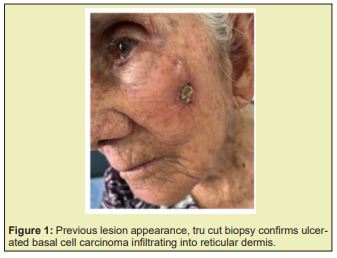
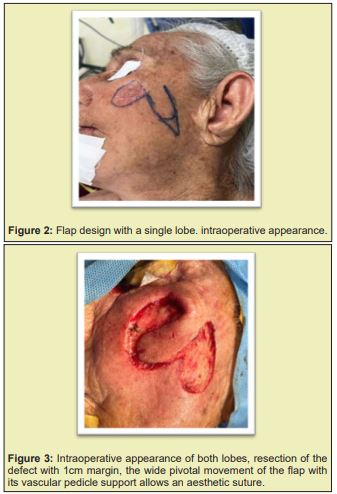
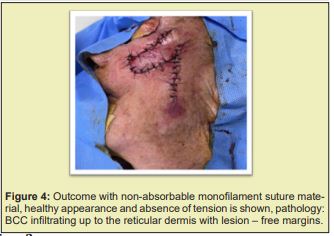
Case 2
An 82-year-old female patient with no personal pathological history, reports an approximately 1-year history of a small ulcer of 0.5cm located on the nose wing that has considerably increased in size over time, with changes in color from brown to erythematous red with slight bleeding. In the last week, the pain has become more intense, the bleeding more frequent, and the lesion has increased in size by approximately 1 cm. As recreational activities of the patient, long exposures to radiation should be mentioned (Figures 5-7).
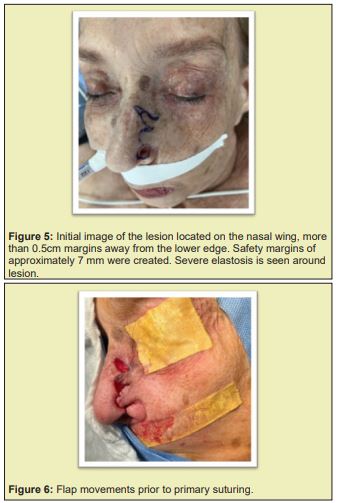
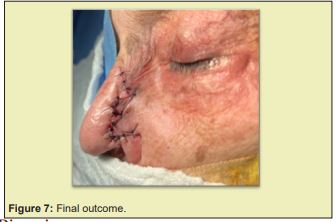
Due to the relative frequency of presentation of this pathology in daily practice and the lifestyle of the elderly population in Paraguay, we are forced to have practical and effective treatments when correcting defects post-extraction of these tumors. It does not require microvascular anastomoses or other local treatments for small lesion. However, it undoubtedly has some disadvantages, such as a lack of skin elasticity, which plays a fundamental role in aesthetic results, as well as limitations in very extensive lesions. The recommended safety margin for lesions smaller than 2cm with well-defined clinical limits is 3-4mm.
Basal Cell Carcinoma is relatively common in daily clinical practice, which is why offering a definitive and practical treatment for the patient with low costs for the healthcare system is essential. This increasingly common pathology in our environment can be treated in different ways, but undoubtedly, surgical treatment has the lowest long-term recurrence rates. For this reason, a flap that is easy to perform and requires local tissues from the patients is ideal in our environment. The bilobed transposition flap in most cases meets the needs of the disease and the skills of the surgeon.
None.
Drs. Marcelo Samudio and Rafael Monzón conceived the idea, worked on the elaboration and literature search, as well as the final review.
The authors declare no conflict of interest.
- 1. Regezi JA, Sciubba JJ. Oral pathology: clinical-pathologic correlations. 3rd edn. Mexico: McGraw-Hill Interamericana; 2000.
- 2. Local Flaps in Facial Reconstruction. 4th Edn. 2023.
- 3. Ramos P, Epidemiology of skin cancer in patients treated at the Department of Dermatology, Faculty of Medical Sciences of the National University of Asuncion, Paraguay (2008-2011). An Fac Cienc Méd. 2012;45(2):49-70.
- 4. Shafer WG, Hine MK. Textbook of Oral Pathology. 4th edn. Philadelphia: WB Saunders; 1993.
- 5. Stewart CM, Garlick J, Mcmullin J, et al. Surgical Excision of Non-Melanoma Skin Cancer in an Elderly Veteran's Affairs Population. Plast Reconstr Surg Glob Open. 2015;2(12):e277.

